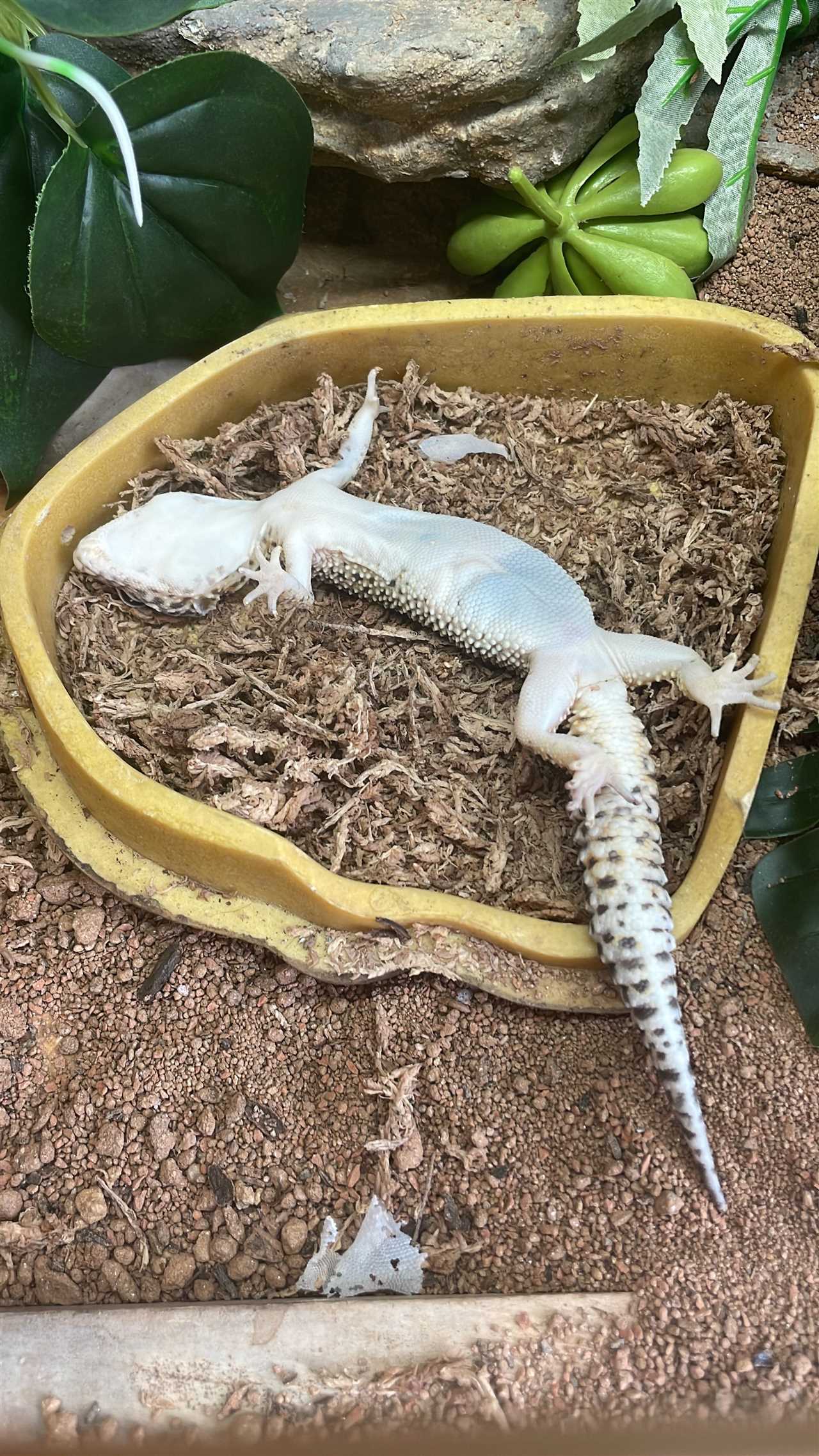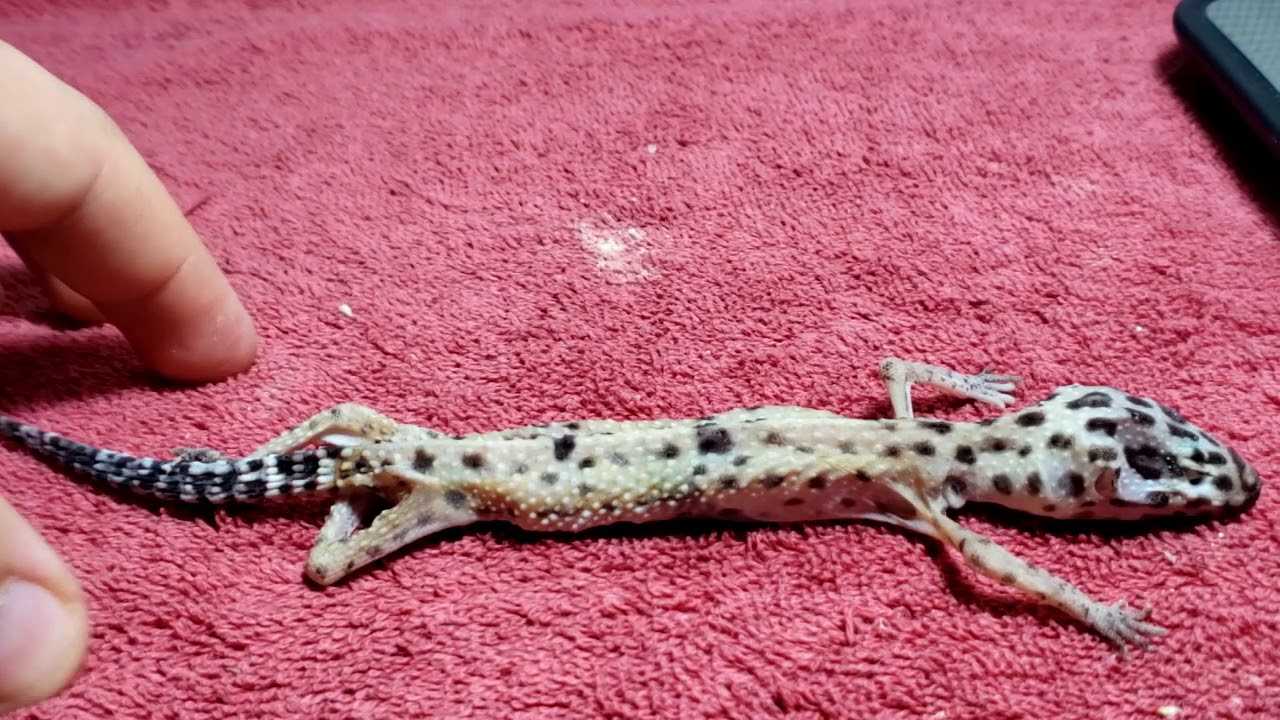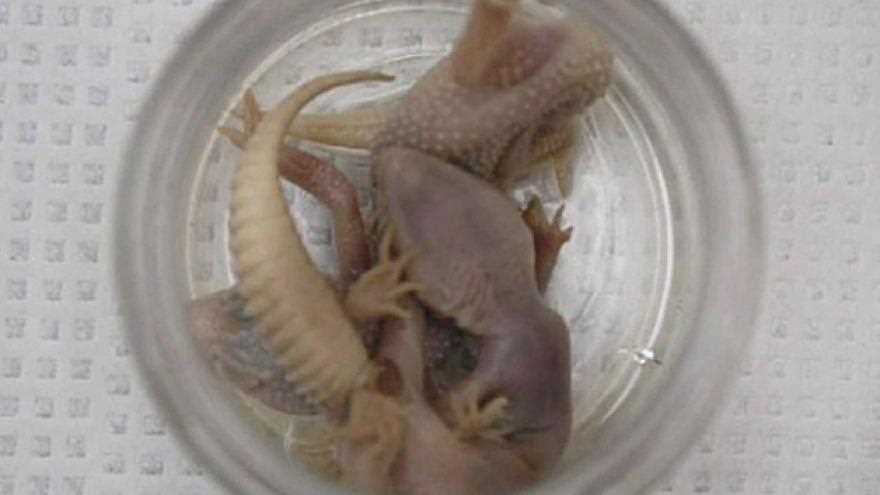
Discovering that your pet leopard gecko is dead can be a devastating experience for any reptile owner. Despite their hardy nature, these beautiful creatures are still subject to illness and stress that can ultimately lead to their untimely demise.
Once you have come to terms with the situation, it is crucial to handle the situation properly. Start by carefully examining your gecko for any signs of life, paying close attention to their eyes and overall responsiveness. If there are no signs of movement, it is likely that your gecko has passed away.
The next step is to ensure the gecko’s body is handled with care and dignity. Prepare a suitable container, such as a small box or container lined with soft bedding, where you can place your gecko. Avoid using any harsh chemicals or substances that could damage the body.
Some owners may choose to bury their gecko in a special location, such as a pet cemetery or their backyard. If you decide to do this, make sure to dig a hole deep enough to prevent scavengers from disturbing the body. Alternatively, you can also contact your local veterinarian or pet crematorium for information on proper disposal methods.
Finally, take the time to reflect on your gecko’s life and the joy they brought you as a pet. Consider reaching out to fellow reptile enthusiasts or online communities to seek support and share your experience. Losing a pet is never easy, but finding comfort in knowing that you provided your leopard gecko with a happy and fulfilling life can bring solace during this difficult time.
Discovering a Deceased Leopard Gecko
Upon closer examination, you may notice that the gecko’s eyes are closed and there may be a lack of blinking reflex. Another telltale sign of a dead gecko is the absence of a tail wag. In live geckos, the tail is often seen twitching or wagging, but in a deceased gecko, this movement is absent.
It is crucial not to panic or jump to conclusions if you see these signs. Make sure to take a closer look and observe any additional signs or symptoms that may confirm the gecko’s death.
| Signs and Symptoms | Description |
|---|---|
| Lack of Movement | The gecko does not respond to touch or stimuli. |
| Stiffness | The gecko’s body feels rigid and unyielding. |
| Closed Eyes | The gecko’s eyes are shut and do not respond to bright light. |
| Absence of Tail Wag | The gecko’s tail does not move or wag in response to stimuli. |
Confirming the Death
| Signs | Symptoms |
|
1. Lack of movement |
Leopard geckos are typically active and agile creatures. If you notice a complete lack of movement from your gecko, it may be a sign that it has passed away. |
|
2. Unresponsive to stimuli |
Try gently touching your gecko or making a noise near its terrarium. If there is no response, it might indicate that the gecko has died. |
|
3. Changes in appearance |
Look for physical changes in your gecko, such as a limp tail or unresponsive eyes. These changes may suggest that your reptile is no longer alive. |
|
4. Lack of breathing |
Observe the gecko’s chest area for any signs of breathing, such as rising and falling. If there is no movement, it could indicate that your gecko has passed away. |
|
5. Foul odor |
A strong and unpleasant smell coming from the terrarium may be a sign that your gecko has died. This odor is caused by the decomposition process. |
Confirming the Death

One way to confirm the death of a leopard gecko is by checking its eyes. A dead gecko’s eyes will often be closed and unresponsive. If the gecko’s eyes remain open, it is possible that it is still alive.
Another important sign to look for is the lack of a tail twitch or movement. Leopard geckos use their tails as a form of communication and defense mechanism. If the tail is limp and showing no signs of movement, it could be an indication of the gecko’s passing.
Examining the gecko’s body for signs of trauma or injury can also help confirm its death. Look for any obvious wounds or damages that may have led to its demise.
Finally, a clear indication of a dead leopard gecko is a lack of breathing. Watch for any rise and fall of the animal’s chest or movement in the throat area. If there is no sign of breathing, it is likely that the gecko has passed away.
Dealing with Your Emotions
Seeking support from friends, family, or fellow leopard gecko owners can be tremendously helpful during this time. Share your feelings and memories with others who understand the unique relationship between an owner and their pet. They can offer comfort, sympathy, and guidance as you navigate through your grief.
Engaging in self-care activities can also aid in the healing process. Take time for yourself to engage in activities that bring you peace and solace. This might include going for walks in nature, practicing meditation or mindfulness, journaling, or seeking therapy. Remember to be patient with yourself and allow yourself the space and time needed to heal.
Additionally, it may be helpful to create a special tribute to honor your leopard gecko’s memory. Consider setting up a small memorial area in your home with a photo, a favorite toy, or a written tribute. This can serve as a meaningful reminder of the love and happiness your gecko brought into your life.
Deciding on a Final Resting Place
Alternatively, if burying your pet is not possible or preferred, you may choose to cremate the body. This option provides a lasting memento of your gecko and allows you to keep their remains in an urn or decorative box. Pet cremation services can be found in many areas and offer various options for memorializing your leopard gecko.
If burial or cremation are not options for you, there are other alternatives to consider. Some pet owners opt for pet cemeteries or memorial parks where they can honor their gecko alongside other beloved pets. Others may choose to have their gecko’s remains professionally preserved or turned into a unique piece of artwork.
It is crucial to carefully consider your preferences and what feels most respectful and meaningful to you when deciding on a final resting place for your gecko. Take your time to evaluate the available options and choose the one that brings you the most comfort and helps you preserve the memory of your cherished reptile companion.
Handling the Body Properly
Firstly, it is crucial to keep in mind that leopard geckos are delicate creatures, especially when they are deceased. Handle the body with extreme care and gentleness to avoid any further damage. Use clean gloves or tissue to avoid any potential contamination or transfer of harmful bacteria.
Find a suitable container for your leopard gecko’s remains. A small, sealed plastic bag or a clean container with a lid would be appropriate. This will help prevent any unpleasant odor and also offer protection against scavengers or insects.
Place the leopard gecko’s body gently in the container. Ensure that the body is positioned in a natural and comfortable resting position. It is common for the eyes to remain open after death, but do not be alarmed. This is a normal occurrence and does not indicate any pain or suffering.
Handle the tail with extra care. Leopard geckos have the ability to voluntarily drop their tails as a defense mechanism. If the tail has detached, carefully place it in the container alongside the body. Be gentle and avoid any unnecessary twisting or bending of the tail.
Once the body and any detached parts are placed in the container, seal it tightly. This will prevent any leakage or odor from escaping. Label the container with the date of your leopard gecko’s passing, as well as any additional information you may find important.
It is recommended to bury your leopard gecko in an appropriate location. Prepare a small grave in your garden or find a suitable pet cemetery. If burying in a garden, make sure it is legal and that you choose a location away from any utilities or potential digging hazards. This way, your beloved pet can rest peacefully.
Remember, it is completely normal to feel emotional during this process. Take your time to grieve and reflect on the memories you shared with your leopard gecko. Seeking support from friends, family, or online communities can be helpful in coping with the loss of a beloved pet.
1. Incorrect Husbandry
Leopard geckos have specific temperature and humidity requirements that need to be met in their terrarium. Failure to provide the appropriate environment can lead to stress, illness, and ultimately, death. Ensure that the temperature gradient, humidity levels, and lighting in the enclosure are suitable for your gecko’s needs.
2. Improper Diet
Feeding your leopard gecko a balanced diet is crucial for its health. Inadequate nutrition or feeding the wrong types of food can result in malnourishment, metabolic bone disease, and other nutritional deficiencies. Research the proper diet for leopard geckos and provide them with a varied and well-balanced menu.
3. Parasites
Internal and external parasites can cause significant harm to leopard geckos. Regularly check your gecko for signs of parasites, such as weight loss, decreased appetite, visible worms, or ticks. If you notice any signs, consult a veterinarian who specializes in reptiles for appropriate treatment.
4. Infections
Leopard geckos are susceptible to various bacterial, fungal, and viral infections. These infections can weaken their immune system and lead to severe illness or death. It is crucial to maintain proper hygiene in their terrarium and seek prompt veterinary care if you suspect an infection.
5. Injury or Trauma
Accidental injuries, such as falls, rough handling, or attacks from other animals, can cause fatal damage to a leopard gecko. Always handle your gecko gently and ensure its enclosure is safe and secure to prevent any accidents or injuries.
| Signs and Symptoms | Possible Causes |
|---|---|
| Lethargy, loss of appetite, weight loss | Incorrect husbandry, improper diet |
| Visible parasites, skin abnormalities | Parasites |
| Respiratory issues, discharge | Infections |
| Visible injuries, fractures | Injury or trauma |
Taking Steps to Prevent Future Incidents

1. Regular check-ups: Schedule regular visits to the veterinarian to identify any potential health issues early on. Regular check-ups can help you catch any problems before they become serious.
2. Proper diet: Ensure that your leopard gecko is receiving a balanced and nutritious diet. Research and consult with a veterinarian to determine the best feeding regimen for your pet.
3. Maintain proper habitat: Provide an appropriate environment for your leopard gecko, including the right temperature, humidity, and substrate. Regularly clean and disinfect the tank to prevent the spread of harmful bacteria or parasites.
5. Handling with care: When handling your leopard gecko, be gentle and avoid any rough or stressful movements. Handle your pet properly to prevent injuries or stress, which can contribute to health problems.
6. Educate yourself: Stay informed about leopard gecko care and welfare. Learning about their specific needs and behaviors can help you provide the best possible care for your pet.
7. Be vigilant: Be vigilant for any signs of illness or distress in your leopard gecko. If you notice any unusual symptoms or behaviors, seek veterinary attention promptly.
8. Take necessary steps: If you suspect that your leopard gecko is unwell, take the necessary steps to address the issue. Seek veterinary advice and follow their recommendations for treatment.
9. Be mindful of potential hazards: Make sure your leopard gecko’s habitat is free from potential hazards such as toxic plants, sharp objects, or other animals that could harm them.
10. Seek professional advice: If you are unsure about any aspect of caring for your leopard gecko, consult a reptile veterinarian or an experienced reptile keeper for guidance.
Taking these steps can help you create a safe and healthy environment for your leopard gecko, reducing the likelihood of future incidents and ensuring the well-being of your pet.
Seeking Professional Help and Support
Coping with the loss of a beloved pet can be difficult, especially when it is a reptile like a leopard gecko. If you are struggling to handle the emotions and practical aspects of dealing with a dead leopard gecko, it may be helpful to seek professional help and support.
There are several resources available to assist you during this challenging time. One option is to reach out to a reptile veterinarian who specializes in exotic pets. They can provide guidance on how to handle the situation and offer advice on proper disposal or burial of the body.
Another option is to contact a local pet loss support group or counselor who specializes in animal bereavement. These professionals are trained to help people deal with the grief and sadness that comes with losing a beloved pet. They can provide a safe space for you to express your emotions and offer coping strategies to help you through the grieving process.
Why Seek Professional Help and Support?
Additionally, seeking professional help and support can help you navigate the practical aspects of handling a dead leopard gecko. They can advise you on the safest way to dispose of the body, ensuring that it is done in a respectful and environmentally friendly manner.
Offering Support to Others
Once you have sought professional help and support for yourself, you may also consider reaching out to others who have experienced a similar loss. Online communities and forums dedicated to reptile enthusiasts can provide a platform for individuals to share their experiences and offer support to one another.
By sharing your story and offering advice based on your own experience, you can help others who are going through a similar grieving process. This not only provides solace to those who are in need but can also be therapeutic for you.
Losing a pet, whether it is a leopard gecko or any other animal, can be a difficult and emotional experience. Seeking professional help and support can provide much-needed guidance and comfort during this challenging time. Remember, you are not alone, and there are resources available to help you navigate the process of grieving and healing.

I’m Lena Adams—a product of an unconventional upbringing in the African wilderness. My father, a daring explorer of African wildlife, sparked my fascination with reptiles, a passion that intertwined with the tragic loss of my mother during an expedition, leaving an indelible mark on my life. Driven to understand the creatures that captivated my parents, I embarked on my journey, sharing insights about reptiles, frogs, and lizards on my website. Through my explorations and conservation efforts, I honour my family’s legacy while seeking connections—to the creatures, nature, and the mother whose presence I yearn to understand.
